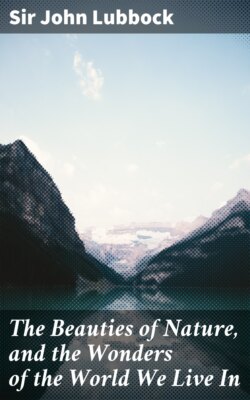Читать книгу The Beauties of Nature, and the Wonders of the World We Live In - Sir John Lubbock - Страница 11
RUDIMENTARY ORGANS
ОглавлениеSuch modifications may be called adaptive, but there are others of a different origin that have reference to the changes which the race has passed through in bygone ages. In fact the great majority of animals do go through metamorphoses (many of them as remarkable, though not so familiar as those of insects), but in many cases they are passed through within the egg and thus escape popular observation. Naturalists who accept the theory of evolution, consider that the development of each individual represents to a certain extent that which the species has itself gone through in the lapse of ages; that every individual contains within itself, so to say, a history of the race. Thus the rudimentary teeth of Cows, Sheep, Whales, etc. (which never emerge from their sockets), the rudimentary toes of many mammals, the hind legs of Whales and of the Boa-constrictor, which are imbedded in the flesh, the rudimentary collar-bone of the Dog, etc., are indications of descent from ancestors in which these organs were fully developed. Again, though used for such different purposes, the paddle of a Whale, the leg of a Horse and of a Mole, the wing of a Bird or a Bat, and the arm of a Man, are all constructed on the same model, include corresponding bones, and are similarly arranged. The long neck of the Giraffe, and the short one of the Whale (if neck it can be called), contain the same number of vertebræ.
Even after birth the young of allied species resemble one another much more than the mature forms. The stripes on the young Lion, the spots on the young Blackbird, are well-known cases; and we find the same law prevalent among the lower animals, as, for instance, among Insects and Crustacea. The Lobster, Crab, Shrimp, and Barnacle are very unlike when full grown, but in their young stages go through essentially similar metamorphoses.
No animal is perhaps in this respect more interesting than the Horse. The skull of a Horse and that of a Man, though differing so much, are, says Flower,[11] "composed of exactly the same number of bones, having the same general arrangement and relation to each other. Not only the individual bones, but every ridge and surface for the attachment of muscles, and every hole for the passage of artery or nerve, seen in the one can be traced in the other." It is often said that the Horse presents a remarkable peculiarity in that the canine teeth grow but once. There are, however, in most Horses certain spicules or minute points which are shed before the appearance of the permanent canines, and which are probably the last remnants of the true milk canines.
The foot is reduced to a single toe, representing the third digit, but the second and fourth, though rudimentary, are represented by the splint bones; while the foot also contains traces of several muscles, originally belonging to the toes which have now disappeared, and which "linger as it were behind, with new relations and uses, sometimes in a reduced, and almost, if not quite, functionless condition." Even Man himself presents traces of gill-openings, and indications of other organs which are fully developed in lower animals.
